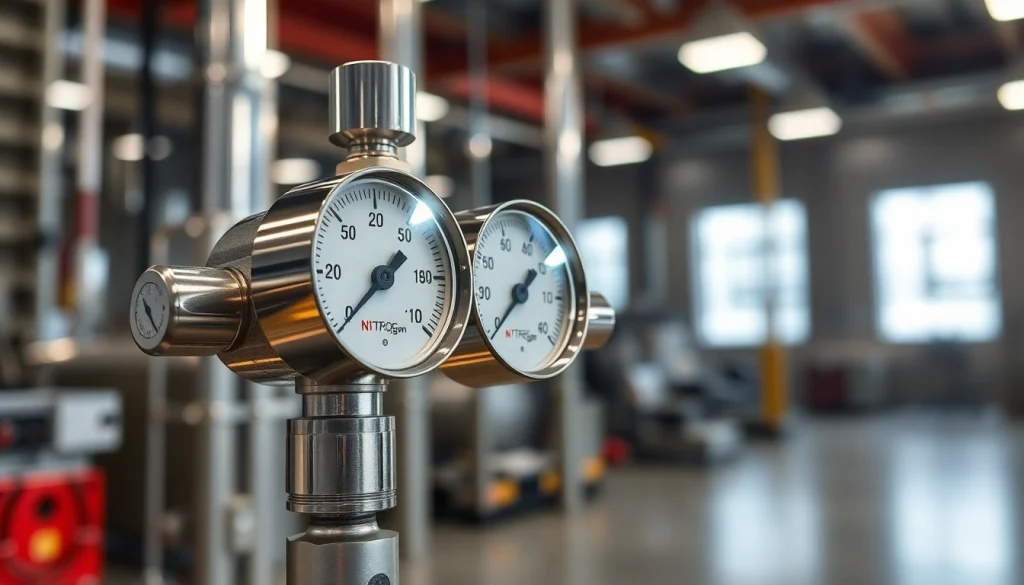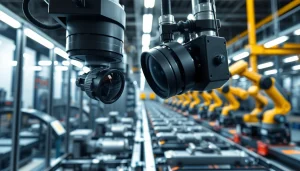High-Performance Nitrogen Regulators: Essential Guide for Effective Gas Control

Understanding Nitrogen Regulators
Nitrogen regulators are essential components in various industries that require controlled gas flow. These devices reduce high-pressure nitrogen from a cylinder to a manageable pressure suitable for operations. A nitrogen regulator not only ensures efficiency but also enhances safety by providing precise control over the gas’s pressure and flow rate.
What is a Nitrogen Regulator?
A nitrogen regulator is a device that controls the delivery pressure of nitrogen gas from storage tanks to application systems. In essence, these regulators manage how much gas is released, ensuring that it meets operational requirements without exceeding the system’s limits. Regulators play a pivotal role in a variety of systems, from brewing to HVAC applications, ensuring nitrogen is delivered safely and efficiently.
Types of Nitrogen Regulators
Nitrogen regulators come in various types, each designed for specific applications and environments:
- Single-Stage Regulators: These are typically used for low-pressure applications. They reduce the cylinder pressure to a usable level with one pressure drop.
- Two-Stage Regulators: More suitable for high-consumption tasks, these regulators offer a finer adjustment of pressure over two stages. They maintain a consistent output despite fluctuations in cylinder pressure.
- High-Pressure Regulators: Designed for systems requiring high pressures, these regulators manage gases under extreme conditions, ensuring safety and performance in critical processes.
- Low-Pressure Regulators: Used in applications that require minimal pressure, they ensure that the gases are delivered without excessive force.
- Specialty Regulators: Some regulators are designed for specific industries, such as brewing or pharmaceuticals, incorporating unique features to meet precise operational requirements.
Key Features and Specifications
When selecting a nitrogen regulator, several features and specifications are crucial:
- Pressure Rating: Each regulator has a maximum pressure rating that defines its operational limit. It’s essential to choose one that matches your application requirements.
- Connection Types: Different applications may require specific fitting types, such as CGA580 or DIN connections. Ensure compatibility with your equipment.
- Material: The material of the regulator can affect its durability and suitability for different gases. Stainless steel is often preferred for corrosive environments.
- Gauge Type: Accurate pressure gauges are vital for monitoring gas flow and ensuring optimal performance. Look for regulators with reliable calibration.
Applications of Nitrogen Regulators
Nitrogen regulators are used across various sectors, each benefiting from the unique properties of nitrogen gas. Here are some prominent applications:
Nitrogen Regulators in HVAC Systems
In HVAC (Heating, Ventilation, and Air Conditioning) systems, nitrogen regulators facilitate pressure testing, refrigerant recovery, and system flushing. Nitrogen is used to purge lines and test for leaks, providing a safe and effective method to ensure system integrity. The regulator controls the nitrogen flow, ensuring that pressure remains within safe limits and enabling technicians to perform their work efficiently.
Industrial Uses of Nitrogen Regulators
Industrially, nitrogen regulators are crucial for various processes, including:
- Welding: Nitrogen is commonly used in welding to prevent oxidation. Regulators ensure a steady flow of nitrogen to protect welds.
- Manufacturing: Many manufacturers rely on nitrogen to create inert atmospheres for chemically sensitive processes. Regulators help maintain these safe environments.
- Material Handling: In applications like oil and gas, nitrogen is used to inert storage tanks and pipelines. Regulators manage nitrogen flow to ensure safe pressure levels.
Specialty Applications: Food and Beverage
Nitrogen is also extensively used in the food and beverage industry. It is commonly used in:
- Beer Dispensing: Nitrogen is used to carbonate and dispense beer, providing a creamy texture. Regulators ensure the correct pressure for optimal serving.
- Food Preservation: By displacing oxygen in packaging, nitrogen extends food shelf life. Specialized nitrogen regulators are used to control the gas levels during packaging.
Choosing the Right Nitrogen Regulator
Selecting the appropriate nitrogen regulator involves careful consideration of various factors that cater to specific needs and applications.
Factors to Consider
When choosing a nitrogen regulator, consider the following:
- Application Requirements: Different applications necessitate different pressure ratings and flow capacities. Clearly define your operational needs.
- Budget: While it might be tempting to choose the cheapest option, investing in a quality regulator can save costs associated with replacements and repairs in the long run.
- Manufacturer Reputation: Opt for brands with a proven track record for reliability and safety. Research customer reviews and industry feedback.
Common Brands and Models
Several brands are renowned for producing high-quality nitrogen regulators, including:
- Victor: Known for their rugged build and reliability, Victor regulators are a staple in the welding industry.
- Smith: This brand offers high-performance regulators suitable for both high and low-pressure applications.
- Uniweld: Uniweld produces specialized regulators designed for specific applications, including food and beverage dispensing.
How to Compare Prices Effectively
When comparing prices, consider the following strategies:
- Feature Comparison: Look beyond the price tag. Compare specifications to ensure you are receiving equivalent products.
- Sales and Discounts: Keep an eye out for promotions from reputable suppliers to secure quality equipment at lower rates.
- Long-term Value: Instead of focusing solely on the initial purchase price, consider the longevity and support policies of the product to determine overall value.
Installation and Maintenance of Nitrogen Regulators
Proper installation and maintenance are crucial for ensuring the efficiency and longevity of nitrogen regulators.
Installation Best Practices
To install nitrogen regulators effectively, follow these best practices:
- Proper Fitting: Ensure that the regulator is compatible with the gas cylinder and downstream equipment. Verify the connection types and sizes.
- Use Teflon Tape: For threaded connections, use Teflon tape to prevent leaks but avoid over-tightening, which can cause damage.
- Check for Leaks: After installation, perform a leak test using soapy water or a leak detector to ensure no gas escapes.
Routine Maintenance Tips
Regular maintenance helps in detecting potential issues before they escalate. Consider these tips:
- Inspect Seals and Connections: Regularly check seals, O-rings, and connections for wear or damage.
- Clean Gauges and Filters: Maintain clear and accurate measurements by regularly cleaning the pressure gauges and filters.
- Calibrate Periodically: Calibration ensures that your regulator provides accurate pressure readings, which is critical for operational safety and efficiency.
Troubleshooting Common Issues
Identifying and addressing common problems quickly can prevent operational disruptions:
- Inconsistent Pressure: If you notice fluctuations in pressure, check for filter blockages or leaks in hoses and connections.
- Gas Leakage: Perform visual inspections and use bubble solutions to locate leaks, paying attention to connections and threads.
- Gauge Failure: If the gauge reading is fluctuating erratically, consider recalibrating or replacing the faulty gauge.
Regulatory Standards and Safety Considerations
Safety is paramount when dealing with gases like nitrogen, which, while inert, can pose risks if mismanaged. Understanding compliance and safety standards is vital.
Understanding Compliance Regulations
Regulatory bodies set standards that must be followed to ensure safe handling and usage of nitrogen gas. For example, OSHA and NFPA outline safety procedures that must be adhered to in industrial settings to mitigate risks associated with gas handling.
Safety Tips for Using Nitrogen Regulators
To ensure safety when using nitrogen regulators, follow these guidelines:
- Ventilation: Ensure the area is well-ventilated to prevent gas accumulation, which can displace oxygen and create hazardous conditions.
- Personal Protective Equipment (PPE): Always use appropriate PPE, including gloves and eye protection when handling compressed gases.
- Regular Training: Conduct training sessions for personnel on the safe use and operation of nitrogen systems regularly.
Resources for Further Information
For more resources on nitrogen regulation and safety standards, consider the following:
- OSHA Website – Guidelines on workplace safety regarding gas usage.
- NFPA Website – Information on fire safety standards related to gases.
- Industry Publications: Journals and articles in industry publications often contain the latest research and best practices for handling nitrogen and other gases.







